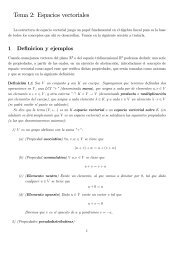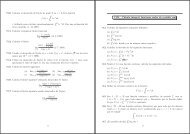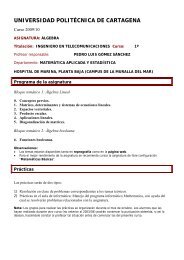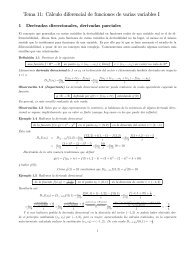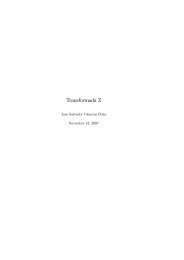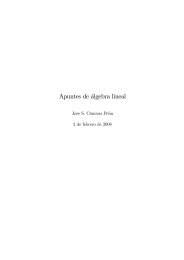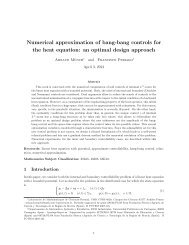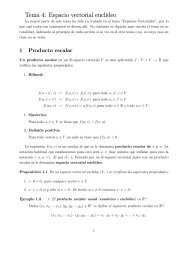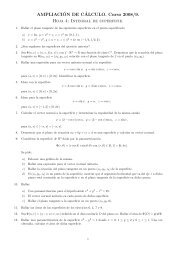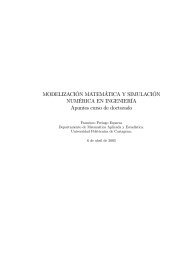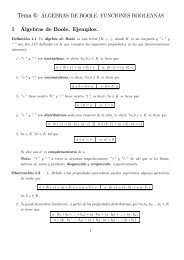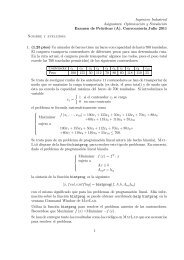Tema 9: Integral de Riemann
Tema 9: Integral de Riemann
Tema 9: Integral de Riemann
Create successful ePaper yourself
Turn your PDF publications into a flip-book with our unique Google optimized e-Paper software.
6<br />
4<br />
2<br />
-1<br />
0 0<br />
-2<br />
1<br />
x<br />
2<br />
3<br />
-4<br />
-6<br />
Gráfica <strong>de</strong> la función f(x) =x 3 − 3x 2 +2x<br />
Observación 3.2 (Importante) En la práctica, halladas las raíces, el área se pue<strong>de</strong> obtener calculando<br />
las integrales en cada uno <strong>de</strong> los subintervalos dados y sumando todos estos números en valor<br />
absoluto. Así no nos preocuparía el signo hasta el final. En el caso anterior se haría así: Una vez<br />
halladas las raíces 0, 1 y 2 los intervalos que nos salen a partir <strong>de</strong>l dado [0, 3] serán [0, 1], [1, 2] y<br />
[2, 3]. Entonces tenemos que el área es<br />
Z 3<br />
0<br />
¯<br />
¯x 3 − 3x 2 +2x¯¯ dx =<br />
¯<br />
Z 1<br />
0<br />
Z (x 3 − 3x 2 +2x)dx<br />
¯ +<br />
2<br />
(x 3 − 3x 2 +2x)dx<br />
¯<br />
¯ +<br />
¯<br />
1<br />
=<br />
1<br />
¯4¯ +<br />
¯<br />
¯−1 4¯ +<br />
9<br />
¯4¯ = 11 4<br />
Z 3<br />
2<br />
(x 3 − 3x 2 +2x)<br />
¯ dx =<br />
Si se pi<strong>de</strong> el área que la función f yelejeOX encierran, sin darnos ningún intervalo, se<br />
sobreentien<strong>de</strong> que es la suma <strong>de</strong> las áreas <strong>de</strong> cada uno <strong>de</strong> los recintos con área finita que<br />
<strong>de</strong>limita la curva y = f(x) con el eje OX.<br />
Ejemplo 3.3 Hallar el área encerrada por la función<br />
f(x) =x 3 − 3x 2 +2x<br />
yelejeOX.<br />
Si tenemos en cuenta que las raíces <strong>de</strong> f son 0, 1 y 2, <strong>de</strong>bemos calcular la integral<br />
Z 2<br />
Z<br />
¯<br />
1<br />
Z ¯x 3 − 3x 2 +2x¯¯ dx =<br />
x 3 − 3x 2 +2xdx<br />
¯<br />
¯ +<br />
2<br />
x 3 − 3x 2 +2xdx<br />
¯<br />
¯ =<br />
1<br />
¯4¯ +<br />
¯<br />
¯−1 4¯ = 1 2<br />
0<br />
0<br />
Nota: Si recordamos la gráfica <strong>de</strong> la función anterior se apreciará mejor la elección <strong>de</strong> los intervalos.<br />
1<br />
3.2 Área encerrada por dos funciones<br />
El área que encierran dos funciones f y g en un intervalo [a, b], interpretadacomolasuma<br />
<strong>de</strong>lasáreaspositivas<strong>de</strong>losrecintosqueencierranlascurvas<br />
y = f(x)<br />
y = g(x)<br />
16



